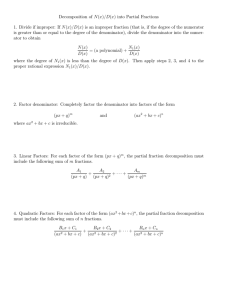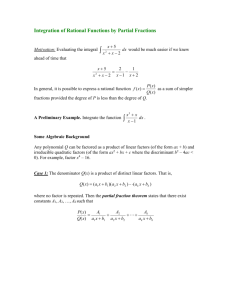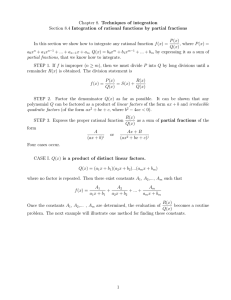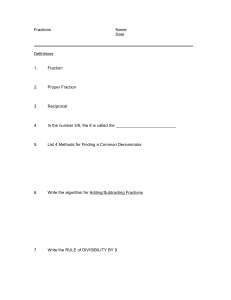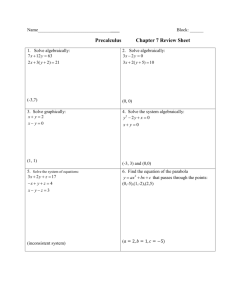LECTURE 19: PARTIAL FRACTIONS February 25, 2015 Theorem 1.
advertisement
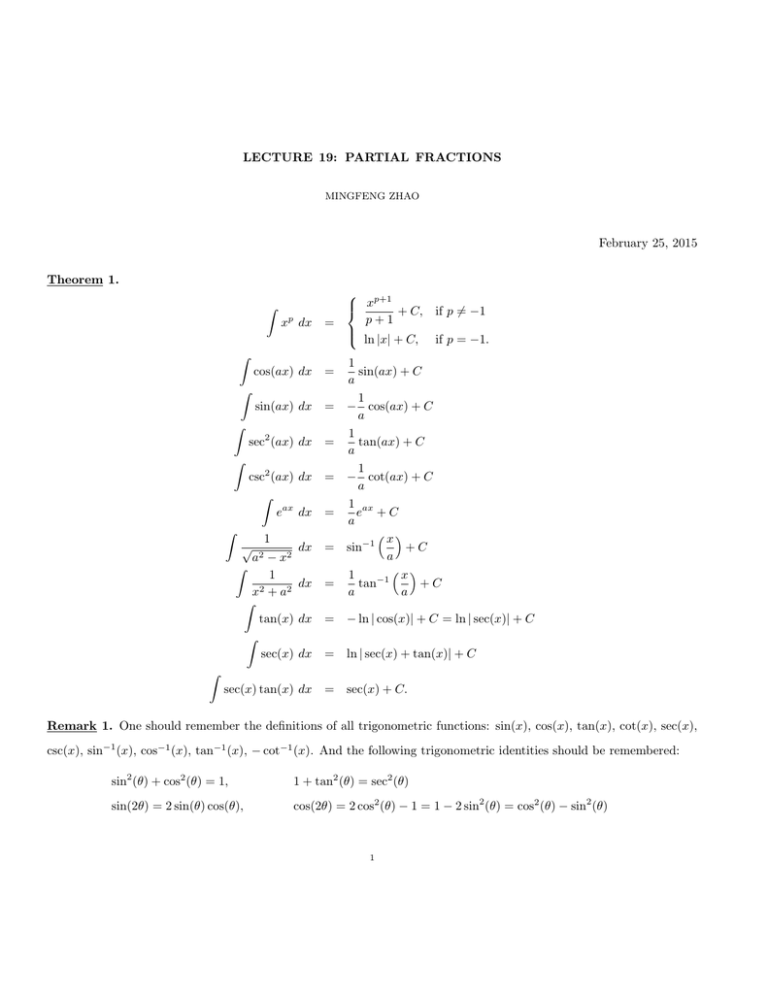
LECTURE 19: PARTIAL FRACTIONS MINGFENG ZHAO February 25, 2015 Theorem 1. Z xp dx p+1 x + C, if p 6= −1 p+1 = ln |x| + C, if p = −1. Z cos(ax) dx = sin(ax) dx = sec2 (ax) dx = csc2 (ax) dx Z eax dx = Z Z Z Z 1 dx a 2 − x2 Z 1 dx x2 + a2 Z tan(x) dx Z sec(x) dx √ = = = 1 sin(ax) + C a 1 − cos(ax) + C a 1 tan(ax) + C a 1 − cot(ax) + C a 1 ax e +C a x sin−1 +C a x 1 tan−1 +C a a = − ln | cos(x)| + C = ln | sec(x)| + C = ln | sec(x) + tan(x)| + C = sec(x) + C. Z sec(x) tan(x) dx Remark 1. One should remember the definitions of all trigonometric functions: sin(x), cos(x), tan(x), cot(x), sec(x), csc(x), sin−1 (x), cos−1 (x), tan−1 (x), − cot−1 (x). And the following trigonometric identities should be remembered: sin2 (θ) + cos2 (θ) = 1, 1 + tan2 (θ) = sec2 (θ) sin(2θ) = 2 sin(θ) cos(θ), cos(2θ) = 2 cos2 (θ) − 1 = 1 − 2 sin2 (θ) = cos2 (θ) − sin2 (θ) 1 2 MINGFENG ZHAO Long division For any polynomials p(x) and q(x), there exist some polynomials g(x) and r(x) such that either r(x) = 0 or deg r(x) < deg q(x) and p(x) = g(x)q(x) + r(x). So we get r(x) p(x) = g(x) + , q(x) q(x) in this case, r(x) is called a proper rational function. q(x) Example 1. Use long division to simplify 2x3 + 11x2 + 28x + 33 . x2 − x − 6 In fact, we have So 2x3 + 11x2 + 28x + 33 53x + 111 = 2x + 13 + 2 . x2 − x − 6 x −x−6 x3 dx. x2 + 1 Use the long division, we have Z Example 2. Evaluate LECTURE 19: PARTIAL FRACTIONS 3 Then x3 x =x− 2 . +1 x +1 x2 So we get Z x3 dx x2 + 1 Z = = Z x dx − x dx x2 + 1 1 2 1 x − ln |x2 + 1| + C 2 2 Partial fractions with simple linear factors p(x) p(x) , where p(x) and q(x) are polynomials with no common factors (that is, is reduced) and with q(x) q(x) p(x) the degree of p(x) less than the degree of q(x) (that is, is proper). Assume that q(x) is the product of simple linear q(x) factors: Suppose f (x) = Step 1. Factor the denominator q(x) in the form (x − r1 )(x − r2 ) · · · (x − rn ), where r1 , r2 , · · · , rn are different real numbers. Step 2. Partial fraction decomposition: Form the partial fraction decomposition by writing: p(x) A1 A2 An = + + ··· + . q(x) x − r1 x − r2 x − rn Step 3. Clear denominators: Multiply both sides of the equation in Step 2 by q(x) = (x − r1 )(x − r2 ) · · · (x − rn ), which produces conditions for A1 , A2 , · · · , An . Step 4. Solve for coefficient: Equate like powers of x in Step 3 to solve for the undetermined coefficients A1 , A2 , · · · , An . 4 MINGFENG ZHAO A dx. x−r Let u = x − r, then du = dx. So we get Z A dx x−r Example 3. Evaluate Z = = dx x−r Z du A u A = A ln |u| + C = A ln |x − r| + C Since u = x − r. 3x2 + 7x − 2 Example 4. Let f (x) = 3 , find the partial fraction decomposition of f (x) and evaluate x − x2 − 2x Step 1. Factor the denominator: x3 − x2 − 2x = x(x2 − x − 2) = x(x + 1)(x − 2). Step 2. Form the partial fraction decomposition: A B C 3x2 + 7x − 2 = + + . 3 2 x − x − 2x x x+1 x−2 Step 3. Clear denominators: 3x2 + 7x − 2 = A(x + 1)(x − 2) + Bx(x − 2) + Cx(x + 1) = A(x2 − x − 2) + B(x2 − 2x) + C(x2 + x) = (A + B + C)x2 + (−A − 2B + C)x − 2A. Step 4. Solve for coefficients: (1) A+B+C = 3 (2) −A − 2B + C = 7 (3) −2A = −2 By (3), then A = 1. Plug A = 1 into (1) and (2), we have (4) B+C = 2 Z f (x) dx. LECTURE 19: PARTIAL FRACTIONS −2B + C (5) = 5 8 By (4)-(5), we have 3B = −6, that is, B = −2. Plug B = −2 into (4), we get C = 2 − B = 4. Hence we get B = −2, A = 1, and C = 4. Therefore, the partial fraction decomposition is: 3x2 + 7x − 2 1 2 4 = − + . x3 − x2 − 2x x x+1 x−2 So we get Z 3x2 + 7x − 2 dx x3 − x2 − 2x Z = = 1 dx − x Z 2 dx + x+1 Z 4 dx x−2 ln |x| − 2 ln |x + 1| + 4 ln |x − 2| + C. Partial fractions for repeated linear factors Suppose the repeated linear factor (x − r)m appears in the denominator of a proper rational function, then the partial fraction decomposition contains the sum: A2 Am A1 + + ··· + . x − r (x − r)2 (x − r)m Example 5. Write the appropriate form of the partial fraction decomposition for x4 x2 + 1 . − 4x3 − 32x2 Since x4 −4x3 −32x2 = x2 (x2 −4x−32) = x2 (x−8)(x+4), then the partial fraction decomposition for x2 + 1 x4 − 4x3 − 32x2 is: x4 x2 + 1 A B C D = + 2+ + . 3 2 − 4x − 32x x x x−8 x+4 Partial fractions with simple irreducible quadratic factors Suppose a simple irreducible factor ax2 + bx + c appears in the denominator of a proper rational function, then the partial fraction decomposition contains a term of the form: Ax + B . ax2 + bx + c 6 MINGFENG ZHAO 10 . (x − 2)2 (x2 + 2x + 2) 10 Since x2 + 2x + 2 is irreducible, then the partial fraction decomposition for is: (x − 2)2 (x2 + 2x + 2) Example 6. Write the appropriate form of the partial fraction decomposition for (x − Cx + D A B 10 + 2 = + . 2 + 2x + 2) x − 2 (x − 2) x + 2x + 2 2)2 (x2 Partial fraction decompositions p(x) be a proper rational function in reduced form. Assume the denominator q(x has been factored q(x) completed over the real numbers and m is a positive integer: Let f (x) = A . x−r with m > 1 in the denominator requires the partial fractions 1. Simple linear factor: A factor x − r in the denominator requires the partial fraction 2. Repeated linear factor: A factor (x − r)m A1 A2 Am + + ··· + . 2 x − r (x − r) (x − r)m 3. Simple irreducible quadratic factor: An irreducible factor ax2 + bx + c in the denominator requires the partial fraction Ax + B . ax2 + bx + c 4. Repeated irreducible quadratic factor: An irreducible factor (ax2 +bx+c)m with m > 1 in the denominator requires the partial fractions A1 x + B 1 A2 x + B 2 Am x + B m + + ··· + . 2 2 2 ax + bx + c (ax + bx + c) (ax2 + bx + c)m Remark 2. Totally there are deg q(x) many coefficients to be determined. 5x2 + 4 . x(x − + 2x + 2)(x2 + 2x + 3)3 then the partial fraction decomposition for Example 7. Write the appropriate form of the partial fraction decomposition for Since x2 + 2x + 2 and x2 + 2x + 3 are irreducible, 5x2 + 4 is: x(x − 2)2 (x2 + 2x + 2)(x2 + 2x + 3)3 2)2 (x2 5x2 + 4 x(x − 2)2 (x2 + 2x + 2)(x2 + 2x + 3)3 = A B C Dx + E Fx + G Hx + I Jx + K + + + 2 + + + 2 . x x − 2 (x − 2)2 x + 2x + 2 x2 + 2x + 3 (x2 + 2x + 3)2 (x + 2x + 3)3 Department of Mathematics, The University of British Columbia, Room 121, 1984 Mathematics Road, Vancouver, B.C. Canada V6T 1Z2 E-mail address: mingfeng@math.ubc.ca
